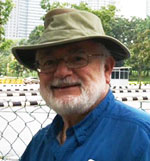By Oliver B. Pollak

RICHMOND, California — We identify role models in the family, high school, college, graduate school, law school, synagogue, and in our chosen professions. As we meet new people they may join the pantheon; when some fall from grace, we may be forgiving but they are no longer role models. Someone said, ‘when you pick your heroes carefully, you don’t need many.’ I thought it was Earl Warren, or maybe Yogi Berra. I have friends who chose Moses. My role models were older than me. It seems that 75, 85, and 95 are not old, it’s the new whatever is 15 years earlier. How old did Moses get, reportedly 120.
My father and mother, refugees from Austria and Germany were my natural role models. My list dwells on educators. John S. Galbraith (1916-2003) my UCLA graduate mentor and Chancellor of the University of California San Diego from 1964 to 1968. Bob and Roberta Rogers, of Omaha’s Gallery 72 extended my appreciation for modern art. Neil Shaver (1924-) of Council Bluff’s Yellow Barn Press introduced me to fine printing. Damodar Sar Desai (1931-2016), was my guru for a while; Thomas N. Bonner (1923-2003) and Peter Stansky (1932-). They all continued researching and writing as octogenarians. They were leaders, students of the human condition, and mostly optimistic. Their guidance and example opened doors.
They were impressive in their energy and longevity, joie de vivre, acuity, criticism of the establishment, and creative minds. Intrepid travelers, they loved their vocations and avocations. They influenced people and public policy. Age is not a barrier; health issues are to be overcome.
Reader’s Digest used to publish stories, “The Most Unforgettable Character I ever Met.” I enjoyed reading them in the 1950s and 60s. Today I find the most unforgettable characters I’ve never met are in the New York Times obituaries.
I met Edith Piness at Denison University in Granville, Ohio in 1975 at a Burma Studies Association conference. We stayed at the historic Buxton Inn which opened in 1812. I had just completed my doctoral dissertation on Burma at UCLA. Edith graduated Wellesley, married and moved to California. She started her doctoral studies while raising three children. She completed her doctoral dissertation at Claremont Graduate School, “Moulmein to Mandalay: sketches of Anglo-Burmese administrators,” under the direction of Allen Greenberger, in 1977.
Denison is a Baptist college that sent missionaries to Burma including Adoniram Judson and Eugenio Kincaid. I was a young scholar grateful that my dean funded the travel and lodging. The conference was multidisciplinary attended by the cognoscenti of Burma and up and coming scholars like Edith and me. I gave my presentation wearing a Gap turtleneck. Both our mentors were role models for research, writing, international travel, and assisting us after we graduated. They had an investment in us.
Edith and I collaborated over the years on articles of political uprisings in Burma in the 1930s, English artists portraying Burma, and together we reread George Orwell’s 1934 novel Burmese Days 50 years later, having first read it in the 1960s. We kvelled and commiserated as The Lady, Nobel Peace Prize winner Aung San Suu Kyi, came out of years under house arrest to lead her country and then were disappointed by the Rohingya debacle.
Edith and George moved from Claremont to Marin in the 1980s. She has served as President of the California Historical Society and ironically for a Jew, on the Board of the California Missions Society. She is active in Planned Parenthood and Democratic politics. As an octogenarian she attends more meetings in a week than I do in a month. George, a nonagenarian gets around the world and the Bay Area without a computer or GPS. They inducted me into the joys of the Bay Area, as if that needed any help, but they did speed it up;
Edith and George travelled the world for business and pleasure. George, a World War II Navy veteran earned degrees at MIT in 1949 and 1950. His father, an early allergist, was president of Wilshire Boulevard Temple in Los Angeles. He was a commercial plumbing representative for hotels and large institutions around the world. Think Koala Kare in airports. These indefatigable travelers have continued their forays after retirement by going to international map conferences and adding to their amazing cartographic collection. They are going to go to a conference in Manila.
We are fans of Burmese food. Nan Yang arrived in Oakland in 1983, the Mandalay in San Francisco on California Street in 1984. Edith and George have introduced innumerable friends to the delights of Burmese cuisine at the Mandalay. Today the Bay Area is an international center of Burmese cuisine with over 30 restaurants. As Sonoma and Napa devotees they introduced us to their favorite wineries.
All our heroes and mentors were compelled to serve, to do good through devotion to worthy causes, to improve the condition in the home, neighborhood, region, and to repair the world, tikun olam. We should do so as well.
I can modestly report emulating my mentors by teaching, writing, counselling, and participating in committee services dedicated to the public good.
*
Pollak, a professor emeritus of history at the University of Nebraska Omaha, and a lawyer, is a SDJW correspondent now based in Richmond, California. He may be contacted via oliver.pollak@sdjewishworld.com